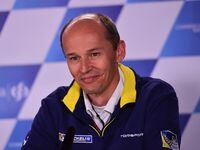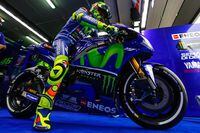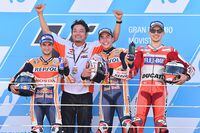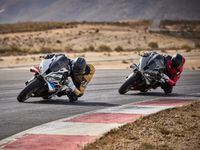"With the options we make available to the riders, we have introduced a variant that did not exist before: a strategy." The speaker is Nicolas Goubert, who until recently was Michelin's racing technical director. Goubert had been asked if giving MotoGP riders three rear tires and even more front options overcomplicated the situation for both the series and the French tire manufacturer.
By offering no fewer than nine tire variants, Michelin effectively paid the price of excellence. With previous supplier Bridgestone, no doubt existed. On paper, there were two options, but in most cases only one actually worked. "Yes, of course, it was easier," Goubert said, "but at the same time if a tire didn't work for a type of rider or motorcycle, it was automatically ruled out for the race. Now everyone has a chance to find one or several combinations that work for them."
The French engineer went on to explain that this new format was actually designed by series rights-holder Dorna. When Michelin returned to the world championship in 2016 as the spec-tire supplier, it initially followed the regulation of bringing two tire options for both front and rear to each race. But as the season progressed, Michelin began to provide a little something extra: a third option.
This evolution culminated this past season as Michelin made three options of front and three rears available to the riders at each Grand Prix. “I think the excitement and uncertainty of the championship exists precisely because there are so many options,” Goubert said. “Riders and teams have several ways to tackle the races. The strategy may be to push hard at first and then manage the tires or vice versa.”
This strategy so often marked the script for this year's races. At MotorLand Aragon, for example, Movistar Yamaha's Maverick Viñales chose a medium front/hard rear combination that required him to wait a number of laps to suitably warm up his rear tire before he could attack. By the time the tire was up to temperature, however, it was too late.
Something similar happened to Marc Marquez (Repsol Honda) as he fought in the front group in the same race on a hard front/hard rear combination against Valentino Rossi (Movistar Yamaha), who used a medium front/hard rear pairing, and Andrea Dovizioso (Ducati Team) on a medium front and a soft rear. None of the three used the same combination. Marquez had to draw from all his skill to not crash during the early moments of the race.
This “all roads lead to Rome” approach was especially evident on the Aragon podium, where it was no coincidence that the top three finishers were Marquez, Dani Pedrosa (Repsol Honda), and Jorge Lorenzo (Ducati Team). Marquez won with the aforementioned hard/hard combo, Pedrosa came in 0.8 second behind with medium front/medium rear, and Lorenzo arrived two seconds later on a medium front and soft rear.
This unique new situation admittedly generated criticism from riders and engineers, who argued that practice basically had become tire-testing sessions instead of race preparation. When there were only two options, there was no choice: You had to take it or leave it. Now that there are three options for each it’s a problem.
But the fact is that, as the situation now stands, it’s no longer a question of just twisting the throttle. Thinking, analyzing, and deciding how to race became equally important and was certainly a key in the final sprint that decided the title in what was arguably the most evenly matched season in history. Now we know what was behind it. In racing, there is always a reason; nothing happens by chance.













/cloudfront-us-east-1.images.arcpublishing.com/octane/AUE3NFVRRZDSBIDVUGIYIDQNUI.jpg)
/cloudfront-us-east-1.images.arcpublishing.com/octane/LYR62CH2WNBMHJJVXVATZHOUE4.jpg)
/cloudfront-us-east-1.images.arcpublishing.com/octane/RBCTRGBQYBDK7A6XPG3HKPS7ZQ.jpg)
/cloudfront-us-east-1.images.arcpublishing.com/octane/MQXQRYMZVBCWJIRYP3HEN3SHVE.jpg)
/cloudfront-us-east-1.images.arcpublishing.com/octane/TSPODNNEWRDSVJGUCNQTDG4ADI.jpg)
/cloudfront-us-east-1.images.arcpublishing.com/octane/X5TB7BDV4BA2RPSY54ZGK27RP4.jpg)
/cloudfront-us-east-1.images.arcpublishing.com/octane/REUHOJXRDBGZ5IHBYZCCBCISPA.jpg)
/cloudfront-us-east-1.images.arcpublishing.com/octane/52LGJTCKBFEHDF7S7H4CVUIMGM.jpg)
/cloudfront-us-east-1.images.arcpublishing.com/octane/YMWAIPIPSJAOXOU3QMJMGH37OM.jpg)


/cloudfront-us-east-1.images.arcpublishing.com/octane/EJ6KZRGAYBCVXNL2PJXL37UVWQ.jpg)
/cloudfront-us-east-1.images.arcpublishing.com/octane/AAN4TI76M5H5JMUVEIGASWXBDU.jpg)
/cloudfront-us-east-1.images.arcpublishing.com/octane/P3RXD2UCPFF37CMB7CHPVKXORY.jpg)
/cloudfront-us-east-1.images.arcpublishing.com/octane/VZEG2EJI2RDFZNHLRZMU56MD3Q.jpg)
/cloudfront-us-east-1.images.arcpublishing.com/octane/GVJQO5FFOFBWNGODOBRB4FBAW4.jpg)
/cloudfront-us-east-1.images.arcpublishing.com/octane/BIVAK2SFIBDJJM25E7I5VU2FJE.jpg)
/cloudfront-us-east-1.images.arcpublishing.com/octane/CH5VX52UG5CFHOVH5A6UYEFWWA.jpg)
/cloudfront-us-east-1.images.arcpublishing.com/octane/ZVGJNGZRU5C33N7KN23BBFKSC4.jpg)


/cloudfront-us-east-1.images.arcpublishing.com/octane/CZ5OM3E43ZEXJHY7LCYXCHLIKI.jpg)
/cloudfront-us-east-1.images.arcpublishing.com/octane/DF5T4K5KPZFJXFCTGPYR77PKJM.jpg)
/cloudfront-us-east-1.images.arcpublishing.com/octane/RMCT2KVQBJHBZMRTSLOVPMOILU.jpg)